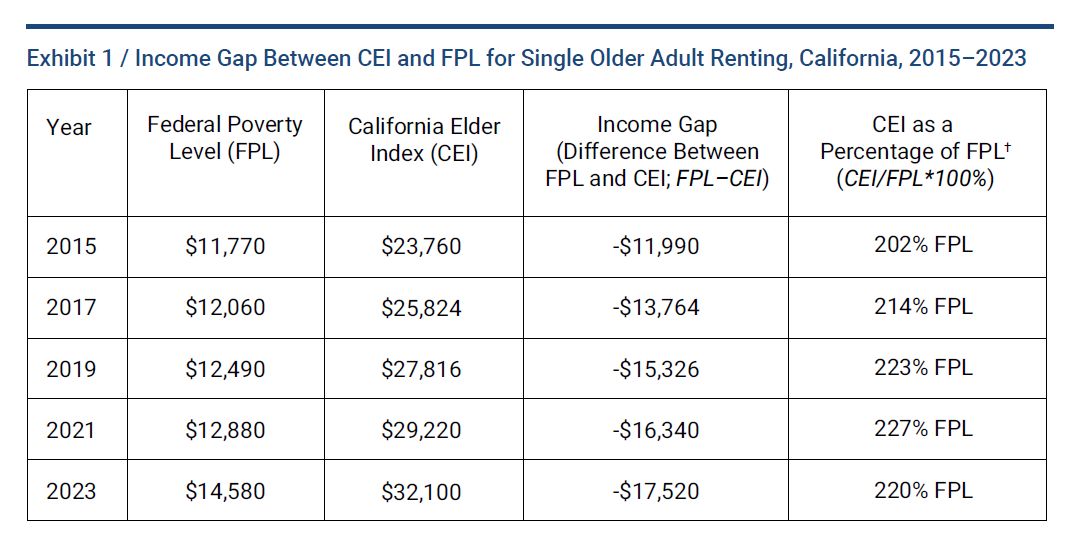Key takeaways
- Older adults with incomes above the federal poverty level still struggle to cover basic living expenses, according to the California Elder Index.
- The average estimated cost for basic living expenses was $32,100 for an older renter living alone, while the 2023 federal poverty level was only $14,580, leaving an income gap of $17,520.
- Single older adults living alone face higher rates of economic insecurity than other family types, especially among women, minoritized groups, those ages 75 and older and renters.
The struggle for Californians ages 65 and older to pay their day-to-day expenses has only gotten worse in the last decade, in particular for older adults who live alone, according to new data from the UCLA Center for Health Policy Research (CHPR).
From 2015 to 2023, the number of single older adults living alone who are economically insecure increased by 19%, from 542,000 to 647,000. During the same time frame, researchers found that the number of economically insecure older couples in a two-person household increased by 26%, from 362,000 to 458,000.
These findings are available now as part of an extensive update of UCLA CHPR's California Elder Index. The CEI is an evidence-based equity tool that provides estimates for basic living costs such as housing, health care, food, transportation and limited miscellaneous expenses faced by adults ages 65 and older.
The federal poverty level, or FPL, guidelines are often used by the federal government to determine income eligibility for government assistance programs, including programs such as Medicaid, known as Medi-Cal in California, and SNAP (CalFresh). The researchers say the new data reinforce what the CEI has illustrated throughout its existence: The federal poverty level ignores important financial context.
"The federal poverty level guidelines are an outdated measure based on food costs only and do not account for other basic living expenses or local costs of living," said Kathryn Kietzman, director of the UCLA CHPR Health Equity Program, of which the California Elder Index is part.
The UCLA CHPR recently updated its free, searchable online data dashboards that allows users to learn more about the economic security of older adults in each of the state's 58 counties. Users can sort by sex, age groups, race and ethnicity, household type (renter versus homeowner) and family type, such as single older adult living alone, older couple, or older adult housing adult children and/or grandchildren.
The new data show how the gap continues to increase between the federal poverty level and the California Elder Index's estimated income needed to cover older adults' basic living expenses.
In 2015, the FPL was $11,770 a year for a single older adult who rents housing. Meanwhile, the estimated CEI cost for that person to pay for very basic living expenses was $23,760, leaving a gap of $11,990, according to the California Elder Index data.

By 2023, the FPL had increased to $14,580, the CEI to $32,100, and the gap increased to $17,520.
"Older adults in California are at greater risk of slipping through cracks in the social safety net because the federal poverty level guidelines don't properly account for differences in cost of living in different parts of the country," said Kietzman, noting that housing, health care, food, transportation and other expenses typically cost more in California than other states.
The California Elder Index builds on earlier work conducted with developers of the national Elder Economic Security Standard Index. By factoring in how costs of living and family types vary in every California county, the CEI provides a more accurate measurement of older adults' economic security, or lack thereof, Kietzman said.
Moreover, the CEI as a percentage of the federal poverty level is consistently greater than 200% of the FPL guidelines.
"What stands out is that by FPL measures, many older adults who struggle paying for very basic necessities are still considered economically secure and therefore ineligible for many support programs," said Imelda Padilla-Frausto, research scientist at the UCLA CHPR and one of the authors of two new fact sheets released as part of the CEI update. One fact sheet focuses on the demographics of older adults with incomes below the California Elder Index. The other highlights health care costs.
"Using the CEI, we can see that many older adults need at least twice as much income as the federal poverty level guidelines to be economically secure," Padilla-Frausto said.
The California Elder Index shows health care costs differ between Medicare and Medicare Advantage
Examining trends in health care costs for older adults between 2013 and 2023, researchers found health care costs increased substantially for older adults with traditional Medicare compared to older adults with Medicare Advantage.
Medicare Advantage plans are an alternative to traditional Medicare, and they often include vision, dental and prescription drug coverage. Medicare Advantage plans have been shown to reduce out-of-pocket health care costs for enrollees.
Using data from the U.S. Centers for Medicare & Medicaid Services, the California Elder Index looks at Medicare Advantage enrollment rates for all 58 California counties.
Counties with higher enrollment rates in traditional Medicare had higher monthly health care costs. The average increase was from $361 in 2013 to $557 in 2023 for a single older adult. In contrast, counties with Medicare Advantage enrollment rates of at least 20% had lower health care costs and a much smaller increase, from $245 to $273. The average monthly health care cost across all California counties for a single older adult grew from $302 in 2013 to $412 in 2023.
The persistence of older adult economic insecurity suggests that a broader policy response is warranted, one that considers health care costs along with other economic and social drivers of health and well-being.
"More than 9 million Californians are currently older than 60 and by 2040 that number is projected to reach 11.4 million, so the time to start developing policy solutions is now," Padilla-Frausto said. "That's how we create a California where older adults can do more than simply get by, they can thrive."






